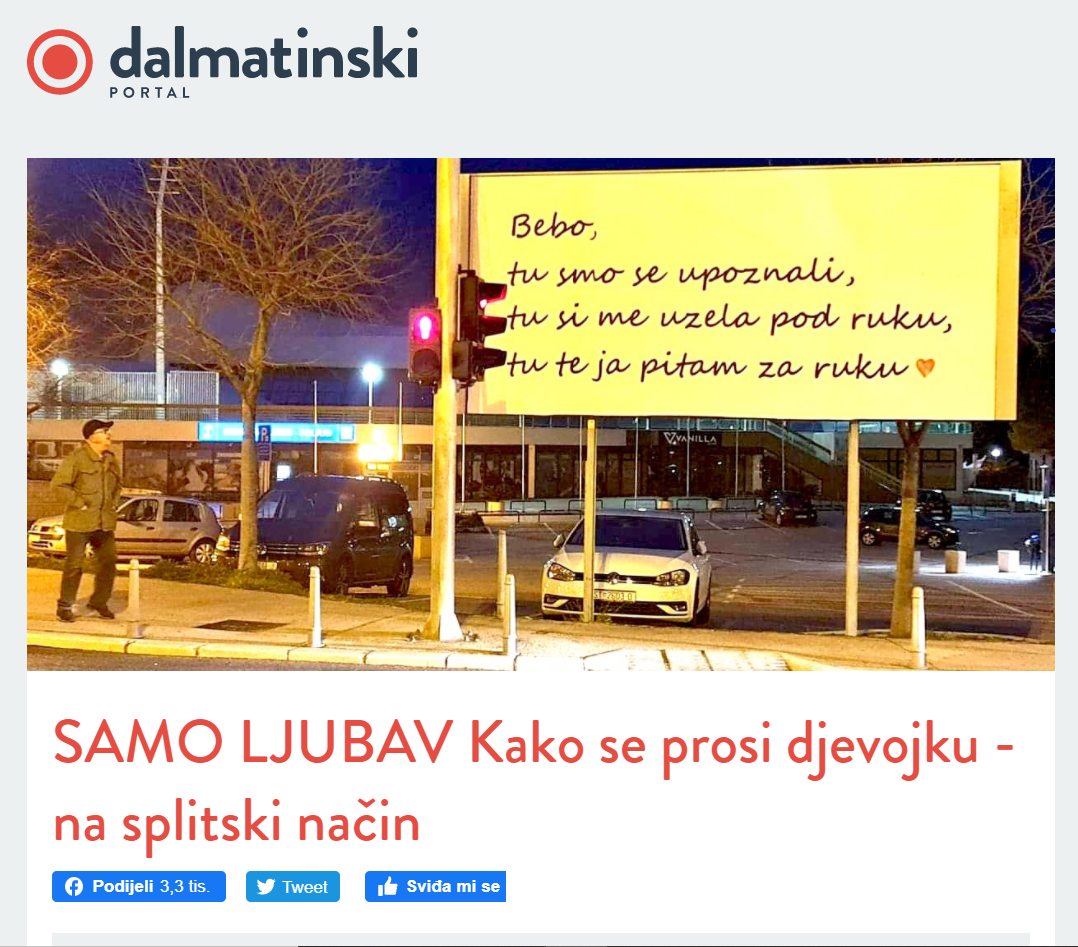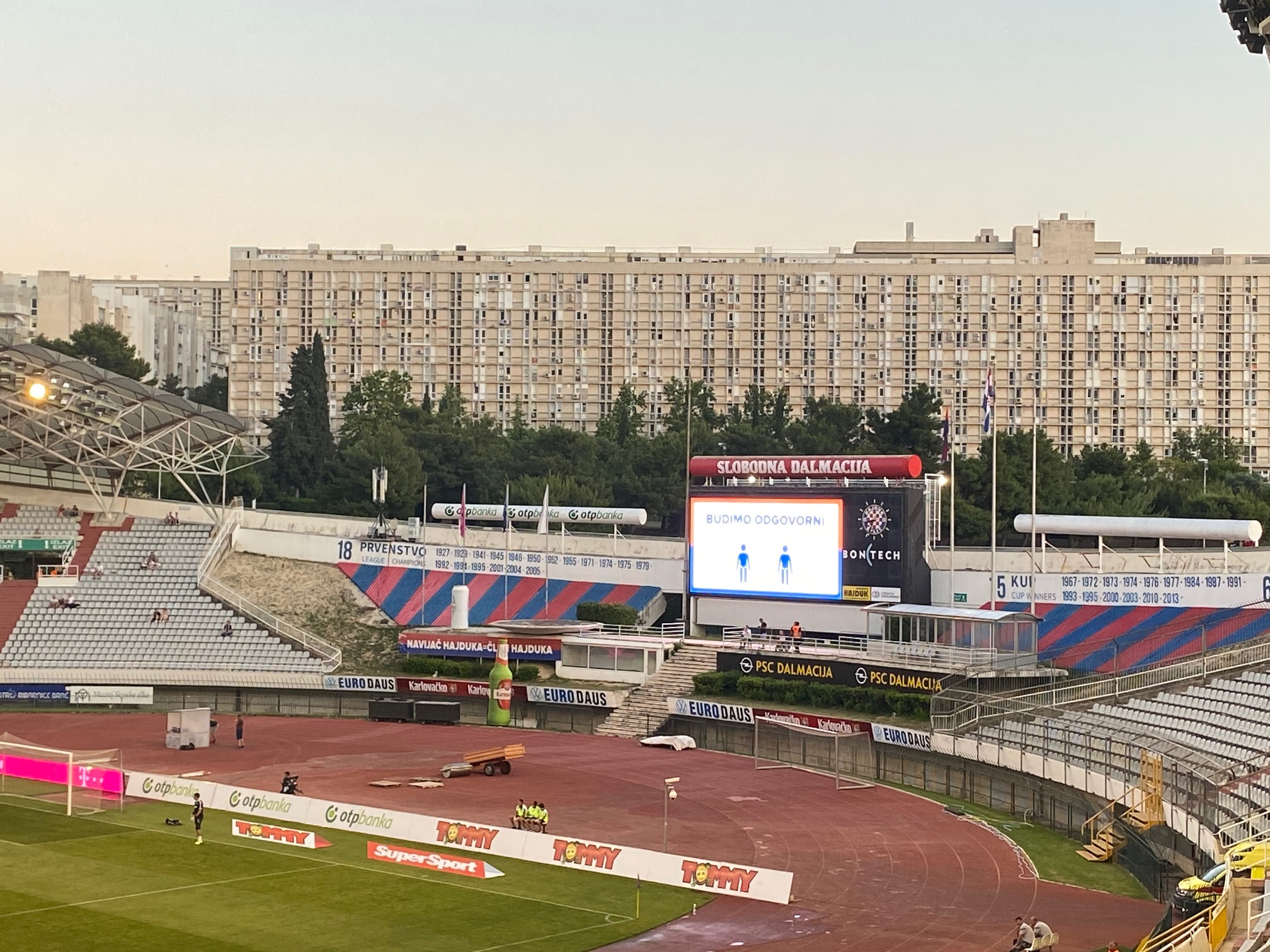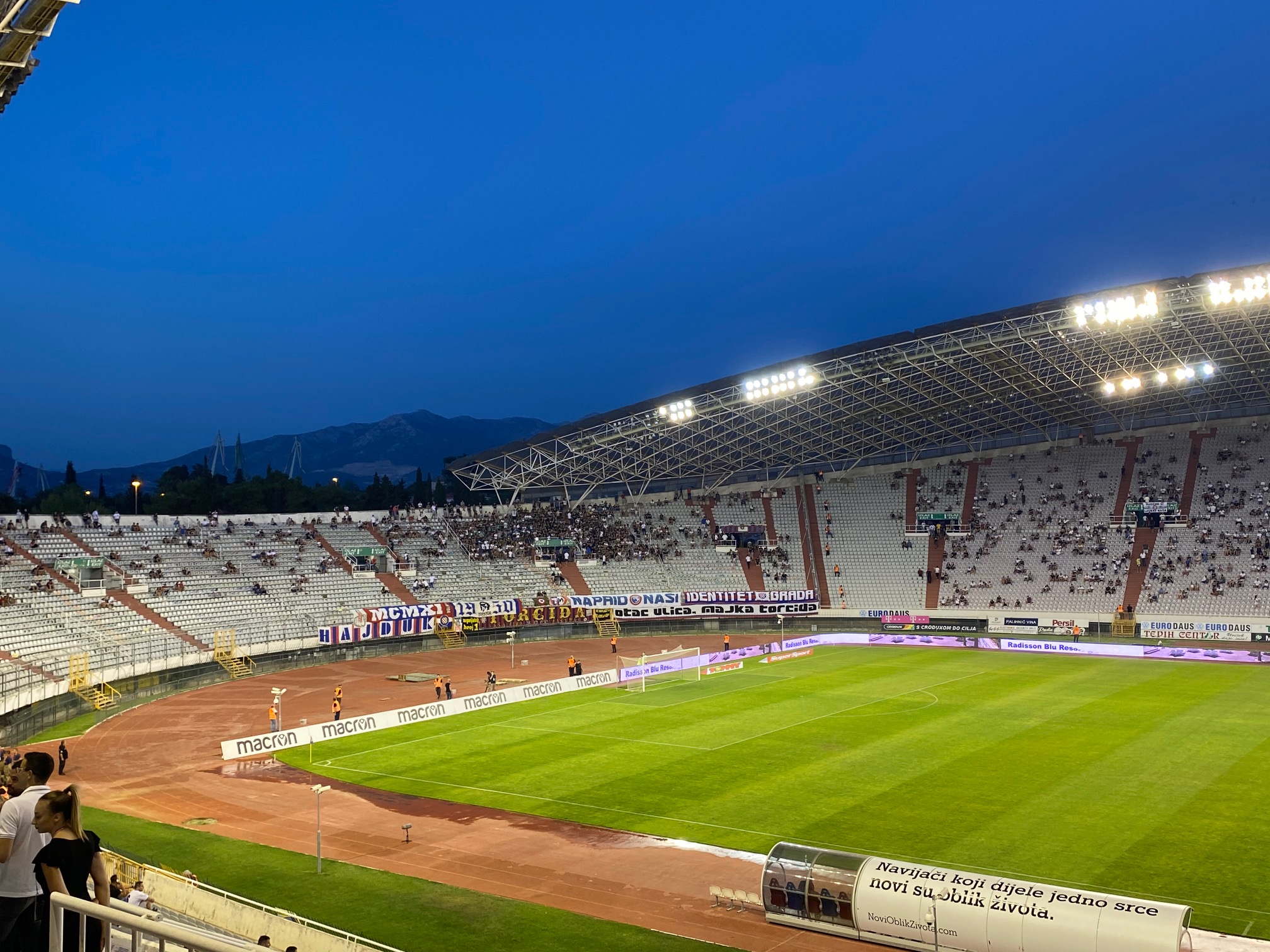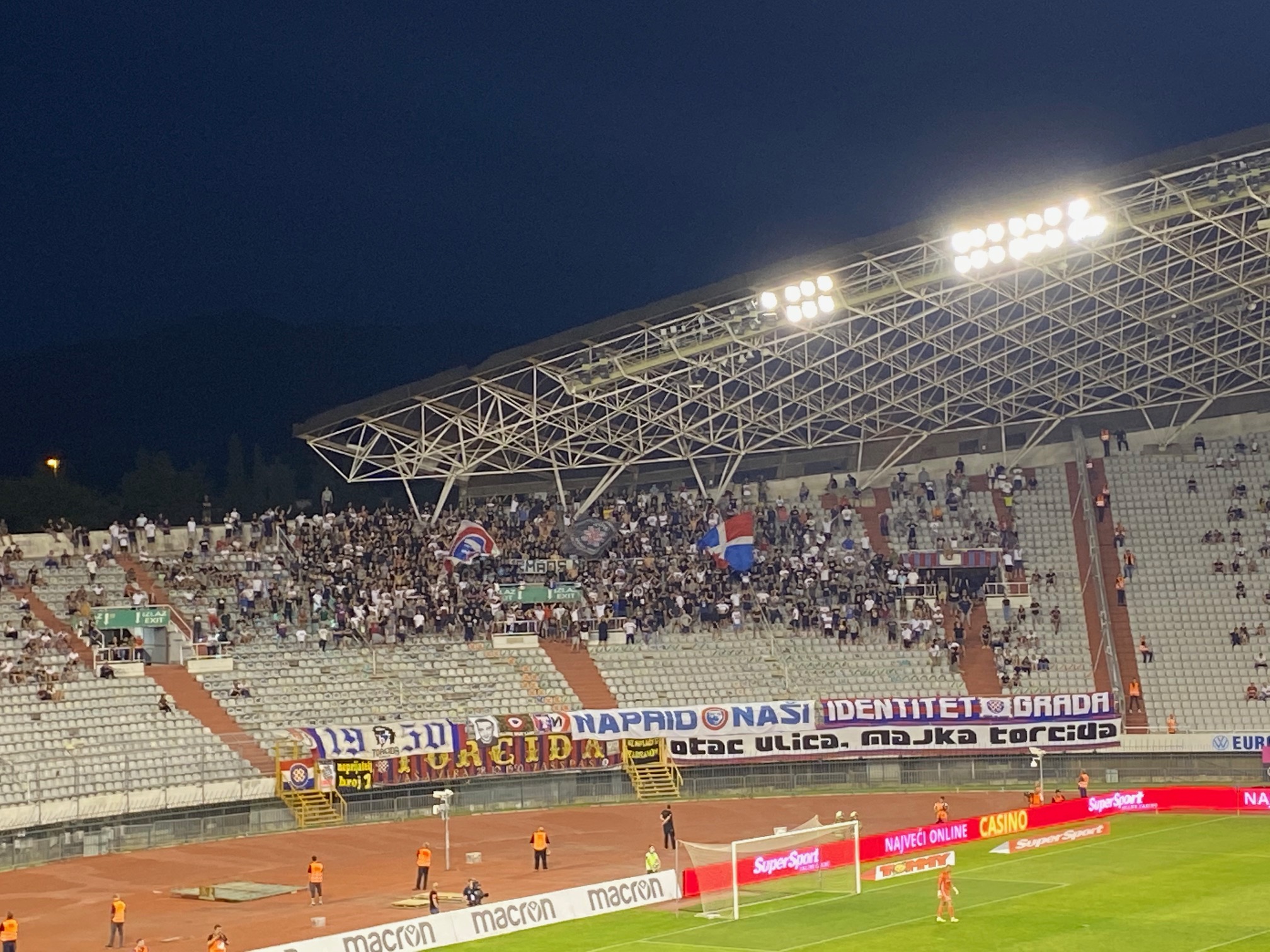Love Declaration: Billboard Proposal In Split Captures Croatia's Heart
February 1, 2021 – A bold declaration of love that first captured hearts in the city of Split has now travelled all across Croatia, as one city resident requested the hand of his beloved in a billboard proposal
Dominating the skyline on the city's northern shores, Poljud is perhaps the best known - and most visually impressive – football stadium in Croatia. Holding near 35, 000 people and boasting sleekly curved roofs on opposite sides, you can't help but admire the relatively modern arena when it is in eyesight.
But, over recent days, the gaze of city residents has drawn by a competing spectacle nearby. In an unabashed declaration of love and intent, one Split resident has placed a billboard proposal within eyesight of the stadium and the local swimming pools. The petition for marriage has captured the hearts of any passing by. How local media outlet Dalmatinski Portal revealed the romantic request. Their story has since been picked up by national media and captured hearts all across Croatia © Dalmatinski Portal screenshot
How local media outlet Dalmatinski Portal revealed the romantic request. Their story has since been picked up by national media and captured hearts all across Croatia © Dalmatinski Portal screenshot
Translated, the text of the billboard proposal reads:
"Baby
Here's where we met
Here's where you took my hand
Here's where I ask for your hand"
The billboard proposal was pictured and the romantic request revealed by local media outlet Dalmatinski Portal. Many Split residents had already seen the billboard proposal for themselves – it is prominently positioned near the crossroads where Osmih mediteranskih igara, Put Supavla and Ulica Zrinsko Frankopanska meet, in the area of the city which is also called Poljud. But, the story has since been picked up by national media in Croatia and has now raised hearts and smiles all across the country. And they say romance is dead!
No word has yet arrived as to whether the billboard proposal has been accepted. Perhaps the response might be issued in a more private manner? Or, if the recipient is as bold in expression as the proposer, perhaps keep your eyes peeled on the billboards of Split for a joyous 'yes'.
Poljud Celebrates 41 Years, 100 Million Kuna Renovation Project in Works
September 6, 2020 - Poljud celebrates 41 years. Retired professor Ante Mihanovic from the Faculty of Civil Engineering, Architecture and Geodesy in Split spoke about the condition of the stadium after so many years, how it could look in a new guise, and how long the renovation works could last.
Slobodna Dalmacija writes Poljud stadium, the work of architect Boris Magas, is celebrating its 41st birthday.
Even as a young engineer and associate of the chief constructor, engineer Bozenko Jelic, Mihanovic participated in the design of the stadium until the main project stage. Then, after construction, he led the monitoring of that demanding construction for more than two decades. A few years ago, also as part of the team of the Faculty in Split, he was one of the reviewers of the stadium renovation project developed by the IGH Institute.
To begin with, he spoke about the reasons why the Faculty carefully monitored the construction of Poljud for more than 20 years:
"A year after its construction, vibrations were noticed in high parts of the auditorium. We found that these are millimeter shifts on the large console, which are insignificant. But they created an uncomfortable feeling, because people are used to vertical vibrations, and not really to horizontal ones.
Also, it was the first time that the company "Mero" had produced a structure that is curved over 200 meters.
"That construction was something new in Europe. As an architectural work, it was met with a lot of praise in the world and it is the only building structure from the former Yugoslavia that has entered the literature of universities in Western Europe. The only!" points out the interlocutor, who is an associate member of the Croatian Academy of Sciences and Arts, a regular member of the Croatian Academy of Technical Sciences, was the dean and vice dean of the Faculty of Split for 12 years and is still active at the age of 71.
Mihanovic continues that there was a 10-year warranty period for the quality of performance.
"Initially, we removed the cracks on the main supports that were expected and the contractor agreed to repair them. So, the stadium was monitored, but not maintained," he notes.
"There are norms in the profession that the City, as the owner of the sports facility, did not respect. Namely, the stadium was supposed to be maintained after the age of 10, considering the steel construction, which means that it is protected against corrosion, dust is removed from it, and to see how the installations, screws and everything else work. Upstairs you also have KIC cabins and trails. Steel structures are generally inspected in detail every five years, and I would say that renovation should be done every 10 years. This has not been done so far."
A few years ago, an initiative was launched from the City to start the renovation, which would replace everything that has not been done for these 40 years.
"It has been warned countless times that a renovation is needed, because the more difficult it is, the more expensive the intervention will be. It has now reached the amount of 100 million kuna, which is a considerable amount. The recent decision to declare the stadium a cultural monument, because it is - a top architectural and construction work, allows you to apply for European funds for rehabilitation."
The IGH Institute won the tender for the preparation of the rehabilitation project, and professors Bernardin Peros and Ante Mihanovic from the Faculty of Split were reviewers.
"We reviewed the entire project on which about 30 experts from the Institute and their associates worked. It has been accepted and is located in the City and in Hajduk, and is on its way to being applied for EU funds. With the realization of this complete project, the stadium will be brought to a state that would be very close to the state after construction."
With one hundred million kuna...
"We will change the lexan cover and metal substructures, use anticorrosive to protect all metal roof structures and remove defects, restore and finally repaint all concrete structures, which will be refreshed in appearance. Then there are interventions on electrical and mechanical installations, and on the fire protection system. The stated estimated amount does not include the interior design of landscaping and lawns."
At one time, the installation of solar panels was mentioned as an idea.
"Solar panels are out of the question because this would change the shape of the roof, and it should be in the same shape as the original. The Belgian factory, which produces lexan boards, has informed those working on the renovation project that they have preserved the molds and are likely to make more favorable offers to make new boards. To this factory, as well as to the company "Mero" from Germany, Poljud stadium was a reference for future business, and they follow everything that happens around," said Mihanovic, who adds:
"The steel substructure is in the worst condition, to which the cover is attached with screws. Due to the substructure, the entire cover must be removed.
It seems that in the construction itself, the substructure was perfectly solved. However, there was a hurry with the construction, the stadium was built in less than two years, so it was not possible to wait for someone else to deliver it.
Also, the structures were partially damaged in the shooting during the war, as JNA soldiers from Lore practiced shooting in some parts of the stadium. There is also damage by the nature of things - zinc and anti-corrosion protection is not preserved everywhere and will have to be partially restored and of course, there will be painting."
Of that 100 million kuna, 40 million kuna are for metal parts - the roof and everything next to it, and 60 million for the concrete structure.
"You have damage and patches on the concrete structure. All damage should be removed, compensated for where the reinforcement is missing, restored and repainted. So all the spectator supporter beams will be renewed. Then you have bridges, tunnels, retaining walls - they all need to be inspected and rebuilt. The bridge on the promenade above Hajduk's premises is in the worst condition because the drainage was not good there and water was retained on it."
The renovation project is complete, says Mihanovic, and, in his opinion, very well made.
The city of Split must act within a certain deadline.
"In my opinion, the renovation should be carried out within 10 years, because after that there will be low reliability of the elements that are overhead, and there will be a risk of someone getting hurt. Also, the longer you wait, the more you will have to invest in renovation. So the sooner you start, the cheaper it will be."
The rehabilitation, he adds, will take several years.
"Objectively, you will not have a hundred teams to attack at once. For example, if you started painting 12,000 rods of steel construction with a group of a dozen people, you would do so for so long that when they get to the other end, you would have to start all over again, provided you renew the paint every five years."
He continues that the stadium will not need to be closed for renovation works.
"Removing the cover and substructure can be done in the period when no matches are held at the stadium. When the renovation of the stands is done, work will be done on one part, and the other part will be used. Therefore, playing matches and partially filling the audience will always be allowed."
Mihanovic says that the stadium is still secure as it stands now.
"But it is simply a thing that ages, weakens day by day, and one day it must be repaired. You can leave it like that for another 20 years, but then it's not certain that some of those lexans won't fly from above."
The documentation is prepared to apply for European funds.
"The application for funds will last at least from a year to a year and a half, followed by a public procurement for the selection of contractors. So, the renovation could start in two years at the earliest. The Poljud beauty will return to its original state, perhaps even better. The value of the stadium is 150 million euro. That is how much it would cost to make a new one. The renovation will cost only 10 percent of that amount. According to that, the building is in relatively good condition.
The designers were obliged to give it a shelf life of 50 years. It is without intervention in the structural parts, but with earlier maintenance. You can't let the construction go, you have to start maintaining it at some point."
The immediate work is numerical modeling, calculations and design of building structures.
"We worked on the calculation and design of the Poljud structure, partly on our own program, and something on the American STRESS, which was installed on "Srca" - University Computing Center in Zagreb," said Mihanovic.
So, what does Hajduk say?
"Project documentation has been prepared, and the City and Hajduk will apply for funding from EU funds from 2021 to 2027. We’re sending out funding applications in September, and we’ll know the results early next year, and maybe sooner. The roof renovation project is worth 102 million kuna, and the museum 44 million," said Marin Brbic, president of Hajduk.
For the latest travel info, bookmark our main travel info article, which is updated daily.
Read the Croatian Travel Update in your language - now available in 24 languages
Join the Total Croatia Travel INFO Viber community.
Hajduk Fans Return to Poljud Stadium after 114 Days
June 26, 2020 - Hajduk and Slaven Belupo met at Poljud Stadium for the 31st round of the Croatian First League. It was Hajduk's first game in front of home fans since the league came to a halt because of COVID-19.
After Gorica topped Rijeka at Rujevica Stadium on Friday night, Hajduk met Slaven Belupo in front of their fans for the first time in 114 days. Recall, while other clubs were able to welcome back their fans already a few rounds ago, the Split club had to serve a punishment of a game behind closed doors.

With the coronavirus on the rise again in Croatia, stricter measures were enforced at the stadium. Namely, temperature checks were reinstated for journalists at the entrance, while we were asked to disinfect our hands before entering. Furthermore, we had to sit one per table instead of the usual two. The jumbo screen at the stadium also reminded fans to keep a distance of 1.5 meters.

Whether they feared the coronavirus would spread or were boycotting because of Hajduk's last two losses and drop to 5th place, the stadium wasn't nearly as full as expected, considering the Split club's beloved fans haven't seen them play in the flesh in almost four months. Namely, only 4,523 fans were in attendance.
Hajduk played with a bit of a weaker squad on Friday night, missing a few starting players due to injuries and yellow cards. Slaven Belupo was also in a weaker form. A win for Hajduk was imperative.
The fans at Poljud showed enthusiasm at the beginning and Torcida's chants certainly helped Hajduk to their first goal. Caktaks scored a penalty for 1:0 in the 10th minute.

Slaven Belupo equalized thanks to an easy goal by Medjimorec in the 25th minute. The game ended 1:1 at the half.
The second half started with only one Hajduk substitution, as Dolcek came on for Colina. Hajduk was quick to score their second goal, which came in the 59th minute. A header by Eduok rattled the Belupo keeper for 2:1!
Belupo was awarded a VAR penalty in the 90th minute, which was hit wide to keep the game 2:1 for Hajduk. Nine minutes of injury time were added, though neither team was able to score. Hajduk won 2:1.
Dinamo and Osijek close out the 31st round on Saturday at Maksimir Stadium. Stay tuned for our 31st round recap on Monday.
To read more about sport in Croatia, follow TCN's dedicated page.
On this Day in 1979, Poljud Stadium Opens in Split
September 12, 2019 - Poljud Stadium, one of Split’s most famous landmarks and the home of football club Hajduk Split, opened exactly 40 years ago today for the VIII Mediterranean Games in 1979.
24 Sata reports that Poljud Stadium was built following the project of prominent Croatian architect Boris Magas in 1979 for the needs of the VIII Mediterranean Games, after which it became the home of Hajduk Split. The stadium, known as "The Poljud Beauty”, is interesting because of its architectural composition - its seashell-like design gives views of the nearby hills, sea, and islands, and was modeled after ancient Greek theaters.
The first football match at Poljud was played three days after the opening, but the attendance record was set in 1982 when there were between 55,000 to 60,000 people at the Split stadium. However, since there was no counter at the time, the exact number is based on speculation. The official capacity of Poljud is about 35,000 people.
Numerous sports and other events have taken place at Poljud, which are still held today. From the games of Hajduk to the Croatia national team, music festivals like Ultra, and concerts of Croatian singers, this building has seen it all.
Unfortunately, architect Boris Magas died in 2013, though some six years later, Hajduk hosted his grandson Bartol Pavusek and thanked him for his work and the efforts of his grandfather.
Although it is still one of the most beautiful stadiums in Croatia, many problems plague the 'Poljud beauty'.
At the time of its construction, Poljud’s comfort, unique roof structure and appearance was unsurpassed even in Europe, and because of this, in 2015, it was included in the list of protected cultural assets of the Republic of Croatia. However, the passing of time and poor maintenance have left their mark.
Some say that Poljud’s roof structure is on the verge of collapsing, which resulted in various suggestions, one of them being that instead of the existing Lexan panels, solar panels would be set up to generate electricity and collect rainwater to irrigate the pitch. The investment would pay off in 10-15 years, but, as usual, paperwork and money got in the way.
In the last few years, Hajduk has made several interventions on rehabilitating and maintaining Poljud, with an investment of almost 40 million kuna. In 2019, a traffic light was repaired, in 2018, the damaged pitch from Ultra was changed, and two auxiliary terrains were built. A year earlier, the dressing rooms and all the facilities, such as the gym, first aid room, and fitness room were updated. Previously, the main pitch was drained and irrigated, and counters, barriers, and video surveillance were introduced.
You can visit Poljud next to see Hajduk face Inter Zapresic and Varazdin, or wait until October for the highly anticipated Euro 2020 qualifier between the Croatia national team and Hungary.
To read more about sport in Croatia, follow TCN’s dedicated page.
Ultra Europe Reveals Second Phase of Artists Performing in Split this Summer
March 25, 2019 - It is the news that many ‘Ultranauts’ around the world have been waiting for… Ultra Europe, the world's only destination festival, has finally revealed the second phase of performers set to take the stage in Split this summer.
What Do Split and Varaždin Have in Common?
If you didn't know, it has to do with football.
Torcida Remembers Kornati Tragedy on Riva Tonight at 19:11
Torcida will remember the heroism of the firefighters that lost their lives on the island of Kornati 10 years ago.
A Message from Split Mayor to Citizens Ahead of Hajduk and Everton Tonight
The mayor has sent a message to the citizens of Split before the match between Hajduk and Everton.
Police, Pamphlets, Poljud: Day One of Everton Fans in Split
My day one observations of Everton supporters in Split.
Hajduk v Everton at Poljud: Tickets on Sale for Everyone Tomorrow!
The general public will be able to purchase tickets for Hajduk v Everton at Poljud from tomorrow morning!


